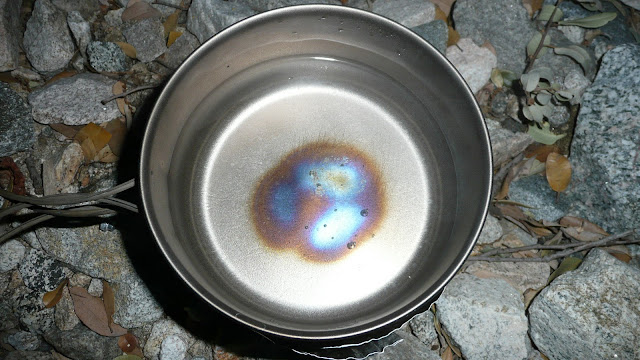To a nice, low simmer.
 |
| A very nice, low simmer with a FeatherFire stove on lowest flame |
Guys, do you see the difference between the two photos above? That's a nice range. And what a great simmer. That's as good of a simmer as I get on a gas stove. And that's "on the fly." In other words, I brought the water to a roiling boil, and then I reduced it to a very low simmer -- without ever taking the pot off the stove. That's pretty darned good. I was impressed.
Well, boiling water is all well and fine, but can it cook?
Fair question. Hmm. Now, let's see. What would be a good test? How about my favorite, an omelet? If an alcohol stove can cook an omelet, then that's a pretty good cooking stove in my opinion. Let's give it a try.
 |
| A small backpacking type pan on a FeatherFire |
 |
| Cooking the eggs |
 |
| Adding salmon and shredded cheese |
 |
| A delicious omelet! |
And the final results? See for yourself. I got nice, fluffy eggs, and I gotta say, it was delicious. And this was with a cheap little lightweight pan. I got a little sticking, but nothing bad. NICE!
 |
| Minor sticking occurred |
So, in summary, this is a really good cooking stove, and
really good for an alcohol stove.
OK, so nice stove, but how's the weight?
On my scale, it weighs 45g/1.6oz. Maybe a little heavy compared to something like a Trail Designs 12-10 stove at 16g/0.6oz, which is about 1/3 the weight, but the FeatherFire's weight includes the pot supports and the little snuffer cap, features not included in the 12-10 stove, and the FeatherFire simmers. On the other hand, compared to the 112g/4.0oz
Trangia burner, the 45g/1.6oz FeatherFire seems as light as, well, a feather.
Downsides? Well, maybe a couple, both in the durability category. First, the pot supports are perhaps a little spindly. I think they could become bent with use. They're surprisingly strong, and I haven't had any problems so far, but I've been careful. Second, will the simmering apparatus stand up to the rigors of the trail? I can't say for sure, but there are more small parts on this stove than on other stoves. No blatant "red flags" here, but something to bear in mind as one uses the stove. Of course, if the band were to fail somehow, you could still use the stove as a non-adjustable chimney stove, so you wouldn't be completely stuck out on the trail. You'd just lose some of the precise simmer control. I haven't had the stove for long, but I actually think the simmering apparatus will be OK. It's those pot supports I worry about. I notice that PackaFeather has a second stove, the XL. The XL is
not an "e
Xtra
Large" version of the FeatherFire but rather appears to be in the same class as the FeatherFire. The XL appears to have improved pot supports of a type that will last well, so it appears that PackaFeather may be well aware of the limitations of the pot supports of a FeatherFire. I have not had a chance to review an XL as of this writing.
One other item of note. Sometimes a FeatherFire "burps." What do I mean by "burp?" Well sometimes you'll hear a pop and there will be a flash of flame. It seems to happen most when you turn up the stove. It doesn't seem to happen at all on fully open or fully closed. But if you're somewhere in between, sometimes the stove just plain burps. I'm not completely sure what's causing it although I suspect vaporized alcohol is escaping out the ventilation ports, building up, and then "flashing" from the heat of the flame when sufficient build up occurs. It doesn't seem to hurt anything although it is a little bit weird. I found that by playing with the flame control setting, I could find "burp free" settings.
I was able to capture what the flame from a burp looks like with my camera.
 |
| The flame from a "burp" on a FeatherFire |
Notice that in addition to the the primary flame arising out of the burner, there's sort of a wraith like flame just under the pot. This is the flame from a "burp." Like I say, odd, but it doesn't seem to hurt anything. If it happens, just adjust the flame knob down a bit and it typically doesn't recur.
The little snuffer cap (0.07oz/2g) that comes with the FeatherFire is kind of handy.
 |
| The snuffer cap of a FeatherFire only weighs two grams! |
Now, if you're just boiling water, you can pretty quickly figure out how much alcohol you need to boil, say, two cups of water. So, in that case, you just dispense the proper amount of alcohol and let the stove burn itself out. But with real cooking, it's a lot harder to predict how much fuel you'll need. With the FeatherFire, don't worry about it. When you're done cooking, close the vents on the stove and put the snuffer cap on. The stove quickly goes out. Hopefully you've got the
excellent PackaFeather cap along with you and you can then just vacuum up the leftover fuel. PackaFeather has put together a nice little system here.
I didn't have a PackaFeather windscreen and heat reflector to test at the time of this writing, so I cannot comment on those items.
The FeatherFire stove: Highly Recommended except
maybe for the pot supports. Time will tell on the pot supports.
Thanks for joining me on another Adventure in Stoving,
HJ
FeatherFire Related Blog Posts

It looks like a nice stove, but it does look a bit fragile.
ReplyDeleteThanks for the review. Could you see it replacing the Trail Designs 12-10 in one of their Caldera cone setups?
ReplyDeleteBill,
ReplyDeleteI think the simmering apparatus will be OK in the long run. It's the pot supports that I worry about. Apparently though in their XL stove they've already addressed this. But boy is that simmer control nice.
HJ
Aushiker,
ReplyDeleteMy mind went there too. It's tough to get a stove that works well in the Caldera Cone because of the low oxygen, high heat environment, but the FeatherFire is a good candidate since the FeatherFire, like the 12-10, is a chimney stove. And if one used the cone, the problem of the FeatherFire's questionable pot supports is no longer an issue.
I haven't tried it yet, but I will try it.
HJ
I agree with you, it's the pot supports that look a bit delicate. I like the way that they have implemented the simmer control, especially the flexible shaft. I think that the stove itself with a separate pot stand or cone, as you mention, might be the way to go.
ReplyDeleteAnd the price is certainly not outrageous.
ReplyDeleteThe build quality is truly excellent. The material seems to be just a bit thicker than the average beverage can. Pretty durable.
ReplyDeleteHJ
Great review. Thank you. Blake
ReplyDeleteHi, Blake,
ReplyDeleteGlad you liked the review.
HJ
Fashion a trial heat reflector with aluminum foil and then retest to see what kind of effect it would have. I am curious as to how it improves the heating of the pot.
ReplyDeleteIf I get a chance, I'll do that. People are sending me a lot of stoves. I'm drowning in stoves, lol! (I love it) I'm testing a combination wood/alcohol/hexamine stove right now as well as a white gas stove. I'll revisit the FeatherFire if I can.
ReplyDeleteHJ
If you get a chance to try it with the Caldera cone that would great. Thanks
ReplyDeleteAndrew
Can do on the Caldera. Now you've got me intrigued.
ReplyDeleteHJ
Had you noticed that the XL stove has a separate fuel cup and the combustion chamber just sits on top of the fuel cup?
ReplyDeleteHi, Bill,
ReplyDeleteI've only seen photos, but yes that's my understanding. Seems a little odd, but the guys I've talked to who have one seem to like it, so I guess it works.
HJ
I tried one of these once. Seemed to work well... but for some reason it just was not the one for me. But great idea and really neat innovation.
ReplyDeleteWallace
Hike, Bike, Dale!
Yeah, it's a really clever way to get good simmering -- on the fly without having to reach in and change something on the stove.
ReplyDeleteIf you're just boiling water (which is all I do on some hikes), then it wouldn't be too useful.
HJ
My concern with the XL is that the components may not fit properly if you don't have a flat surface to set them on.
ReplyDeleteHi, Bill,
ReplyDeleteI agree. I don't quite understand it. The FeatherFire is solidly held together. It seems counterintuitive to have them be separate. Maybe PackaFeather is trying to cut labor costs? I really don't know.
HJ
Great review, Bill. This is my first visit to your excellent site. I have a previous version of the Featherfire which has a different simmering mechanism. The vent ring around the outside on my version has holes that correspond with the holes on the chimney element. The simmer ring then rotates to match the holes up (high flame) or stagger them (low flame). Same principal, same worm gear. I do wonder why they changed it. Anyway, mine has seen a thousand miles or so and I can tell you that it is a great stove. The simmering function isn't just for simmering either. It helps you match pot size so there isn't any lost flame up the side of the pot. I have used it up to 13000 feet and down to about 25 degrees f. Works great. The pot support has trouble on uneven or debris strewn ground, but that is easily remedied (move the stove or clean the ground).
ReplyDeleteHi, Sean,
ReplyDeleteThanks for your comments. It's nice to get some input from someone who has been using the stove for a while.
HJ